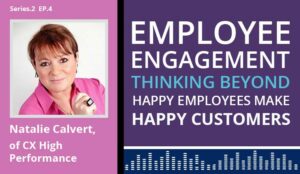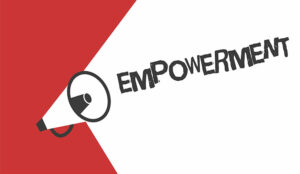We present an approach for calculating employee engagement in the contact centre that also provides insight into what may be causing spikes and dips in staff happiness.
4 Conventional Techniques for Measuring Employee Engagement
Before we get into our suggested method, let’s take a look at four classic ways of measuring employee engagement in the contact centre.
1. Periodic Employee Surveys
Perhaps the most common method for measuring employee engagement is to survey advisors anonymously – every month, quarter or year.
These surveys can be great when looking for patterns in open feedback. We can also ask the same closed questions over a certain period of time and look for trends in the answers we receive.
Yet to measure engagement through surveys, Gallup suggest asking the following twelve questions to members of your team, formed after 30 years of behavioural economic research:
- Do you know what is expected of you at work?
- Do you have the materials and equipment to do your work right?
- At work, do you have the opportunity to do what you do best every day?
- In the last seven days, have you received recognition or praise for doing good work?
- Does your supervisor, or someone at work, seem to care about you as a person?
- Is there someone at work who encourages your development?
- At work, do your opinions seem to count?
- Does the mission/purpose of your company make you feel your job is important?
- Are your associates (fellow employees) committed to doing quality work?
- Do you have a best friend at work?
- In the last six months, has someone at work talked to you about your progress?
- In the last year, have you had opportunities to learn and grow?
These questions provide can useful insights, especially if we track how the answers to each question change over time.
But should we be asking the same long list of questions, month after month?
No. That in itself is disengaging and we want to discover new insights.
Although if we change our questions, we are ultimately changing our metric, so we cannot track it over a long period of time and spot trends.
For more information on using surveys to calculate a score for employee engagement, read our article: How to Calculate an Employee Engagement Score
2. Employee Net Promoter Score (ENPS)
This involves periodically asking advisors one simple question: “On a scale of 1 to 10, how likely is it that you would recommend your employer to a friend.”
You would then use the following calculation to create a percentage score – with detractors being those who gave a score of between 1 and 6 and promoters being advisors who responded with an 8, 9 or 10.

As this is such a simple way to gauge employee engagement, it is easy to survey the team regularly and track the overall response to contact centre changes.
Also, we can split the results amongst different teams to find out how engagement rates vary across the contact centre.
But while this does give us an easy metric score to benchmark, as it’s such a simple question, we don’t get as much actionable insight as with some of the other methods.
For more on this metric, read our article: How to Calculate an Employee Net Promoter Score (ENPS)
3. One-to-Ones
One-to-ones are a great method for obtaining open feedback and looking for trends. They also allow us to gain an idea of employee engagement at an individual level, if we make advisors feel comfortable in a safe environment.
Informal conversations provide a real sense of what actually matters to individuals, and we can dig deeper when the advisor says something really insightful.
Another benefit is that informal conversations provide a real sense of what actually matters to individuals, and we can dig deeper when the advisor says something really insightful or with lots of passion.
However, we cannot rely solely on this method, as it can be very difficult to create the “safe space” for advisors to openly share information about how engaged they are.
In addition, as this method relies on informal conversations, we can’t provide any meaningful data to track over time – so we cannot create a reliable metric to track.
4. Viewing Attrition Rates
Engaged employees are less likely to leave your organization. Therefore, attrition rates can be a good indicator of engagement. And, to a lesser extent, so too can absence rate.
However, the trouble with using attrition rate in this way is that it is a “lag indicator”. This means that by the time we have found out that certain members of the team are disengaged, it is too late to do anything about it, as they have left the organization.
If we look back through our trends in attrition, we may gain insight as to what is causing disengagement and learn, so that we don’t repeat certain mistakes in the future.
If we look back through our trends in attrition though, we may gain insight as to what is causing disengagement and learn from our mistakes, so that we don’t repeat them in the future.
Also, if we look at attrition rates in certain parts of the employee journey, e.g. phases in induction training, we can constantly evolve our training plan to become more engaging…
But Do These Techniques Measure Employee Engagement or Advisor Satisfaction?
Employee engagement must be connected to customer engagement because that connection tells you whether your method for measuring employee engagement is working for your business.
Yet in any of the techniques above, did we ever reference the customer? No.
Unless we are connecting our measures for engagement with the customer, are we really measuring employee engagement or advisor satisfaction?

Natalie Calvert
Natalie Calvert, Founder of CX High Performance, asks us to consider: “If you go into a shop and see lots of happy staff doing their own thing, using their mobile phones and enjoying themselves, they will likely be satisfied employees, but are they really engaged with their work?”
So, the critical link, which many organizations miss, is in tracking employee engagement alongside your customer experience measures, as soon as advisors make it onto the contact centre floor.
However, there are other stages to the advisor journey – before they start talking to customers.
With this in mind, if we wish to gain the best possible insight into employee engagement, we want to be analysing engagement at different stages of the advisor life cycle…
The Key Is to Measure Employee Engagement at Different Points in Their Journey
When calculating employee engagement, try not to think about it as one single measure. If so, we miss lots of key insights.
Instead, we want to consider utilizing different measures of employee engagement at different stages of the employee journey – where they are best suited.
“Just think about the various stages of your employee life cycle, from recruitment to onboarding and so on. For each stage to be effective, it needs to be measured,” says Natalie.
With a simple framework for an employee journey map, we can attach a method for measuring engagement that is most relevant to each stage.
Below is how we recommend calculating engagement at each of the first four key stages, along with some of Natalie’s expert advice.
Stage 1 – Recruitment
The best measure of engagement in this first stage is a metric called “attraction to recruitment“.
According to Natalie: “This is a measure of how many people do I need to be attracting to get the number of people I need for my contact centre?”
Measure attraction to recruitment by simply calculating the ratio of how many candidates are interviewed compared to how many are recruited.
With this definition in mind, we can measure attraction to recruitment by simply calculating a ratio of how many candidates are interviewed compared to how many are recruited.
While we can go deeper into that, by looking at particular attributes like skill level and calibre, fundamentally we want to track how easy it is to attract the right talent.
If we track this over time, we can compare how successful recruitment campaigns have been over time, identifying which strategies have worked best in terms of engaging the community. It may also inform us of the optimum time to recruit.
Another benefit of tracking this measure is that if we detect that engaging with potential recruits is getting increasingly difficult, we can use this in a business case for homeworking, to build our recruitment pool, as many contact centres currently are doing.
Stage 2 – Onboarding
Often, there’s a time lag between recruitment and people joining a company, because traditionally, in contact centres, people are recruited in batches, as it’s easier for us to manage. This time period is otherwise known as “onboarding”.

While, in some companies, this can just be a two-week period, for others it can be anything up to six weeks or maybe even two months.
So, within this time period, there is another metric to consider, and this is called “recruit to join“.
Recruit to join is the percentage of those people that have accepted our offer to come and work for us who are still “onboard” by the first day of induction.
One way to think of this is as an attrition rate over the onboarding period, as is clear to see when we consider the formula below:

In an ideal world, this would be 100%. However, those of us within the contact centre industry know that this is often not the case.
So this is a metric that we want to track, to see how our communication during the onboarding period can be improved to better ensure that we are engaging recruits in this time period and that we are consistently hitting that 100% mark.
“To get to that 100% mark, there are some fantastic portals (like Capterra) that have been produced to keep people involved in the business and already start the induction process before people join,” suggests Natalie.
Stage 3 – Induction
For contact centres where complex topics are discussed and numerous processes need to be learned, inductions can take as long as six to eight weeks.
In this time, recruits can be quite a burden to the organization, taking up lots of management time, office space and other resource. For this reason, we also want to measure something called “time to competency“.
Time to competency is a measure of how long it takes to make our people competent, and the first step is to define what competent means.
Simply put, this is a measure of how long it takes to make our people competent, and the first step is to define what competent means.
“An example of how you could define competent is when an advisor is consistently able to hit a certain percentage in their quality scores. Let’s say 80%,” adds Natalie.
“Then you would measure how long it takes to get everybody from your recruitment group up to that 80% mark. That time is your time to competency.”
Once we are calculating this time, we want to see it gradually coming down as we introduce new strategies to better engage recruits with their learning.
It can also be good to calculate “new employee attrition” across each of the key stages of induction – not just the whole induction period, as we can draw the wrong conclusions from that.

By pinpointing the exact moments where advisors leave, we can draw strong conclusions as to where we are disengaging recruits.
Maybe we are misrepresenting the role in recruitment? Perhaps advisors are being left unsupervised too early? Or could our classroom training possibly be a little uninspiring? By knowing exactly when advisors are leaving the induction process, we can better answer these questions.
Stage 4 – Steady State
On day one, we want everyone to be “competent”. But as people get increasingly confident in their role, we expect them to grow and improve.
Yet there will come a stage where performance plateaus. We call this the”steady state”, and when we get to this stage, to truly measure an employee’s engagement, we want to be measuring two things.
The first measure is “the percentage of people above average“. So we are finding a median average score for metrics like customer satisfaction and quality scores, seeing what percentage of our recruits – once they have reached their steady state – are above that median mark.
Across the whole team we can also split recruits into quartiles in terms of certain metrics and see which techniques the first quarter (Q1), with the best results, are using to boost those metrics.

Split everyone into quartiles in terms of certain metrics and see which techniques the first quarter (Q1), with the best results, are using to boost those metrics.
Then, we want to train those techniques to those in Q2, Q3 and Q4. The aim is for Q2 to achieve the scores of Q1, Q3 to achieve the scores of Q2, and Q4 to achieve the scores of Q3.
How well we can do this over a certain period of time, let’s say six months, is a great indicator of how well advisors are engaged in their own development. Then, after those six months, move the parameter.
The second measure is “capability“. This is a measure of whether or not advisors have the right level of skills and are using the techniques and technologies in the right way to deliver our level of customer experience.
How you measure this will vary from one contact centre to another, by looking over customer-facing metrics and conducting regular “skills dips”.
Think of skills dips as testing the customer journey and assessing whether advisors sound engaged, know their stuff and are being friendly with customers.
4 Mistakes to Avoid When Measuring Employee Engagement
While you may choose to consider our approach to measuring employee engagement or not, here are four mistakes to avoid in all of your calculations.
1. Just Measuring It Annually
At minimum, to get a good handle on employee engagement and ensure that we have the opportunity to address the downside, we need to be measuring it quarterly.
Put simply, measuring engagement as part of an annual survey is meaningless to the contact centre, as it doesn’t help contact centre leaders to manage engagement in a good way.
Measuring engagement as part of an annual survey is meaningless to the contact centre, as it doesn’t help contact centre leaders to manage engagement in a good way.
For example, maybe we installed a system several months ago that advisors didn’t respond well to and that could be the reason behind lower engagement. But how will we ever know if we track engagement just once a year, when so much has gone on in the meantime?
2. Not Understanding the Employee Journey
Not understanding and measuring the individual stages of an employee journey is a big mistake when measuring employee engagement.
If we can pinpoint exactly where we are causing disengagement, we can use these insights to make changes at the most beneficial moment in the employee journey, for both the advisor and the customer.
So we want to create a framework for the employee journey, highlighting key stages, and create a plan as to how we can measure engagement at each.
3. Not Getting the Right Analytics Behind Your Questions
If we’re measuring engagement through surveys and interviews, we need to have the right question set and understand the analytics that sit behind that.
We want to have a clear strategy, so that we can interpret our results in a way that is meaningful.
However, when we choose to measure employee engagement, we want to have a clear strategy, so that we can interpret our results in a way that is meaningful.
We also need to ensure that it is joined, fundamentally, by what employees are doing and what the customer wants.
As Natalie says: “When we improve employee engagement, are we delivering improved acquisition? Improved retention? Improved loyalty? And if we’re missing one of these key targets, why are we missing it?”
4. Using It as a Measure for Mental Health
While we can say that 70% of our employees are engaged, for example, that does not get into the real stresses and strains within our contact centre.
There are other signals out there that we have to work with our managers to deal with in a really professional way. We can’t rely on a score to act as the signal, as that approach will not work.
“We can measure employee engagement and advisor satisfaction to find that our staff are generally happy and working well, but underpinning that, we will likely find mental health issues,” adds Natalie.
So, separate to our employee engagement plan, it is good to have a health and fitness agenda, which helps to reframe advisor minds and get the team away from just sitting at a desk all day.
For more on this important topic, read our article: A Guide to Improving Mental Health in the Contact Centre
In Summary
There are many traditional methods of calculating employee engagement, including advisor surveys, ENPS and one-to-one interviews.
However, if we are not connecting our method for measuring employee engagement with our intended customer outcomes, we are not really measuring employee engagement, we are measuring advisor satisfaction.
So, when putting together a strategy for measuring employee engagement, we want to consider this and also look carefully at the employee journey.
Then we can use a range of measures for calculating engagement at different stages within the customer journey, where they are most appropriate. This will help us to gain the best possible insights.
For more articles on the topic of employee engagement and how to improve it in the contact centre, read our articles:
- How to Improve Agent Engagement
- 13 Ways Technology Can Improve Employee Engagement
- Key Performance Indicators (KPIs) Are Damaging Employee Engagement
Natalie discusses employee engagement in even more detail in a recent podcast of The Contact Centre Podcast, as found below.
The Contact Centre Podcast – Episode 10:
Employee Engagement – Thinking Beyond Happy Employees Make Happy Customers
For more information on this podcast visit Podcast – Employee Engagement: Thinking Beyond Happy Employees Make Happy Customers
Author: Robyn Coppell
Reviewed by: Megan Jones
Published On: 4th Mar 2020 - Last modified: 16th May 2024
Read more about - Call Centre Management, Editor's Picks, Employee Engagement, How to Calculate, Natalie Calvert, Staff Recognition




































